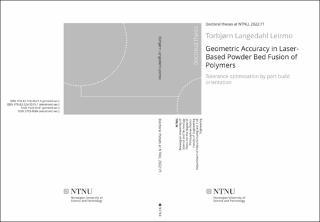Geometric Accuracy in Laser- Based Powder Bed Fusion of Polymers: Tolerance optimization by part build orientation
Doctoral thesis
Permanent lenke
https://hdl.handle.net/11250/2981868Utgivelsesdato
2022Metadata
Vis full innførselSamlinger
Sammendrag
As Additive Manufacturing (AM) enters the manufacturing industry, the technology must adhere to stringent quality demands in terms of dimensional and geometric accuracy. However, due to substantial differences in how these technologies realize three-dimensional geometries, generalization of phenomena across AM technologies proves to be quite difficult.
Laser-based Powder Bed Fusion (LB-PBF) is an industrialized AM technology capable of producing functional components and end-use parts. However, to ensure consistent quality for larger production volumes in a mass-customization setting, automated optimization methods and process planning must be developed. This requires valid and reliable data to enable the construction of prediction models.
This thesis is centered around the optimization of part build orientation in LB-PBF of polymers (LB-PBF/P) for which a deterministic method is proposed. The proposed method utilize mathematical models for the effect of part build orientation on the accuracy of various geometric features. To this end, an experiment has been conducted to generate data for empirical modeling. Two new models are devised for the prediction of cylindricity and flatness based on the experimental data.
Variations within and between production runs in LB-PBF/P obscures the validity of experiments. The first Research Question (RQ) addresses this issue and aims at generating valid data for the subsequent analysis. A matrix layout in four dimensions is developed that enables the control of experimental variables while gauging the effect of part placement and production run. The experimental plan successfully enables the analysis of geometric and dimensional properties as a function of part build orientation. Furthermore, the design makes it possible to characterize the variation within and between different builds. The variation is found to be significant in the y-direction of the build chamber, while x- and z-directions appear to be more stable.
The second RQ utilizes the experimental data to reveal the effect of part build orientation on the geometric accuracy of planes and cylinders. First, the data is analyzed, and the conformance of theoretical models is evaluated. This analysis reveals that existing models insufficiently explain the effect of part build orientation on the geometric accuracy of planes and cylinders. Therefore, novel empirical models are proposed to better assimilate the observed behavior. The proposed empirical models differ in shape from the theoretical models which are based on the staircase effect. This indicates that the staircase effect alone cannot precisely predict the accuracy of LB-PBF/P. Moreover, the proposed models may widen the range of allowable orientations while meeting tolerance requirements.
Finally, a third RQ aims at developing a deterministic method for optimizing accuracy by part build orientation. Mathematical foundations are provided, and a method is described for identifying optimal part build orientations given the geometric features of the part. The proposed method relies on basic information about constituent geometric features and can be populated with any differentiable function for each identified feature type. Through the identification of critical points in a continuous solution space, the optimal orientations are obtained.
The main contributions of this thesis concern the modeling accuracy as an effect of part build orientation where the novel model for cylindricity is particularly disruptive. For future work, the effect of part build orientation on other tolerance characteristics should be investigated, and the work should be extended to other materials and AM technologies. Furthermore, the intelligence of such data and models may be integrated into a digital pipeline for quality assurance throughout the value chain, and the product’s life cycle.
Består av
Paper 1: Leirmo, Torbjørn; Martinsen, Kristian. Evolutionary algorithms in additive manufacturing systems: Discussion of future prospects. Procedia CIRP 2019 ;Volum 81. s. 671-676Paper 2: Leirmo, Torbjørn; Martinsen, Kristian. Deterministic part orientation in additive manufacturing using feature recognition. Procedia CIRP 2020 ;Volum 88. s. 405-410
Paper 3: Leirmo, Torbjørn Langedahl; Semeniuta, Oleksandr; Martinsen, Kristian. Tolerancing from STL data: A Legacy Challenge. Procedia CIRP 2020 ;Volum 92. s. 218-223
Paper 4: Leirmo, Torbjørn Langedahl; Semeniuta, Oleksandr; Baturynska, Ivanna; Martinsen, Kristian. Extracting shape features from a surface mesh using geometric reasoning. Procedia CIRP 2020 ;Volum 93. s. 544-549
Paper 5: Leirmo, Torbjørn Langedahl; Semeniuta, Oleksandr. Investigating the Dimensional and Geometric Accuracy of Laser-Based Powder Bed Fusion of PA2200 (PA12): Experiment Design and Execution. Applied Sciences 2021 ;Volum 11.(5) s. -
Paper 6: Leirmo, Torbjørn Langedahl and Semeniuta, Oleksandr. ‘Minimizing form errors in additive manufacturing with part build orientation - An optimization method for continuous solution spaces,’ Open Engineering, vol. (Accepted for publication – Open Access)
